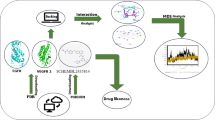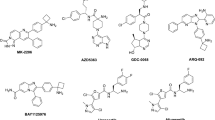Abstract
Purpose
Exosomes are membrane-derived nano-vesicles upregulated in pathological conditions like cancer. Therefore, inhibiting their release is a potential strategy for the development of more efficient combination therapies. Neutral sphingomyelinase 2 (nSMase2) is a key component in exosome release; however, a clinically safe yet efficient nSMase2 inhibitor remains to be used discovered. Accordingly, we made an effort to identify potential nSMase2 inhibitor(s) among the approved drugs.
Methods
Virtual screening was performed and aprepitant was selected for further investigation. To evaluate the reliability of the complex, molecular dynamics were performed. Finally, using the CCK-8 assay in HCT116 cells, the highest non-toxic concentrations of aprepitant were identified and the nSMase2 activity assay was performed to measure the inhibitory activity of aprepitant, in vitro.
Results
To validate the screening results, molecular docking was performed, and the retrieved scores were in line with the screening results. The root-mean-square deviation (RMSD) plot of aprepitant–nSMase2 showed proper convergence. Following treatment with different concentrations of aprepitant in both cell-free and cell-dependent assays, nSMase2 activity was remarkably decreased.
Conclusion
Aprepitant, at a concentration as low as 15 µM, was able to inhibit nSmase2 activity in HCT116 cells without any significant effects on their viability. Aprepitant is therefore suggested to be a potentially safe exosome release inhibitor.





Similar content being viewed by others
Data availability
All data generated or analyzed during this study are included in this published article.
References
Abad E, Lyakhovich A (2022) Movement of mitochondria with mutant DNA through extracellular vesicles helps cancer cells acquire chemoresistance. Chem Med Chem 17(4):e202100642
Baghban R, Roshangar L, Jahanban-Esfahlan R, Seidi K, Ebrahimi-Kalan A, Jaymand M, Kolahian S, Javaheri T, Zare P (2020) Tumor microenvironment complexity and therapeutic implications at a glance. Cell Commun Signal. https://doi.org/10.1186/s12964-020-0530-4
Berger M, Neth O, Ilmer M, Garnier A, Salinas-Martín MV, de Agustín Asencio JC, von Schweinitz D, Kappler R, Muñoz M (2014) Hepatoblastoma cells express truncated neurokinin-1 receptor and can be growth inhibited by aprepitant in vitro and in vivo. J Hepatol 60(5):985–994
Bilousova T, Simmons BJ, Knapp RR, Elias CJ, Campagna J, Melnik M, Chandra S, Focht S, Zhu C, Vadivel K (2020) Dual neutral sphingomyelinase-2/acetylcholinesterase inhibitors for the treatment of Alzheimer’s disease. ACS Chem Biol 15(6):1671–1684
Butt SS, Badshah Y, Shabbir M, Rafiq M (2020) Molecular docking using chimera and autodock vina software for nonbioinformaticians. JMIR Bioinform Biotechnol 1(1):e14232
Cetin R, Quandt E, Kaulich M (2021) Functional genomics approaches to elucidate vulnerabilities of intrinsic and acquired chemotherapy resistance. Cells 10(2):260
Datta A, Kim H, McGee L, Johnson AE, Talwar S, Marugan J, Southall N, Hu X, Lal M, Mondal D (2018) High-throughput screening identified selective inhibitors of exosome biogenesis and secretion: a drug repurposing strategy for advanced cancer. Sci Rep 18(1):8161
Dong LF, Rohlena J, Zobalova R, Nahacka Z, Rodriguez AM, Berridge MV, Neuzil J (2023) Mitochondria on the move: Horizontal mitochondrial transfer in disease and health. J Cell Biol. https://doi.org/10.1083/jcb.202211044
Elsherbini A, Bieberich E (2018) Ceramide and exosomes: a novel target in cancer biology and therapy. Adv Cancer Res 140:121–154
Figuera-Losada M, Stathis M, Dorskind JM, Thomas AG, Bandaru VVR, Yoo S-W, Westwood NJ, Rogers GW, McArthur JC, Haughey NJ (2015) Cambinol, a novel inhibitor of neutral sphingomyelinase 2 shows neuroprotective properties. PLoS ONE 10(5):e0124481
Hekmatirad S, Moloudizargari M, Moghadamnia AA, Kazemi S, Mohammadnia-Afrouzi M, Baeeri M, Moradkhani F, Asghari MH (2021) Inhibition of exosome release sensitizes U937 cells to PEGylated liposomal doxorubicin. Front Immunol 12:692654
Houshyari M, Taghizadeh-Hesary F (2022) Is mitochondrial metabolism a new predictive biomarker for antiprogrammed cell death Protein-1 immunotherapy? JCO Oncol Pract:OP 22:00733
Im E-J, Lee C-H, Moon P-G, Rangaswamy GG, Lee B, Lee JM, Lee J-C, Jee J-G, Bae J-S, Kwon T-K (2019) Sulfisoxazole inhibits the secretion of small extracellular vesicles by targeting the endothelin receptor A. Nat Commun 10(1):1387
Javid H, Afshari AR, Zahedi Avval F, Asadi J, Hashemy SI (2021) Aprepitant promotes caspase-dependent apoptotic cell death and G2/M arrest through PI3K/Akt/NF-κB axis in cancer stem-like esophageal squamous cell carcinoma spheres. BioMed Res Int 2021:1–12
Jin G, Wong ST (2014) Toward better drug repositioning: prioritizing and integrating existing methods into efficient pipelines. Drug Discov Today 19(5):637–644
Khan FM, Saleh E, Alawadhi H, Harati R, Zimmermann W-H, El-Awady R (2018) Inhibition of exosome release by ketotifen enhances sensitivity of cancer cells to doxorubicin. Cancer Biol Ther 19(1):25–33
Koch R, Aung T, Vogel D, Chapuy B, Wenzel D, Becker S, Sinzig U, Venkataramani V, von Mach T, Jacob R (2016) Nuclear trapping through inhibition of exosomal export by indomethacin increases cytostatic efficacy of doxorubicin and pixantroneinhibition of exosomal drug export by indomethacin. Clin Cancer Res 22(2):395–404
Kosgodage US, Trindade RP, Thompson PR, Inal JM, Lange S (2017) Chloramidine/bisindolylmaleimide-I-mediated inhibition of exosome and microvesicle release and enhanced efficacy of cancer chemotherapy. Int J Mol Sci 18(5):1007
Mahmoud R, Ordóñez-Morán P, Allegrucci C (2022) Challenges for triple negative breast cancer treatment: defeating heterogeneity and cancer stemness. Cancers 14(17):4280
Moloudizargari M, Asghari MH, Abdollahi M (2018) Modifying exosome release in cancer therapy: how can it help? Pharmacol Res 134:246–256
Moloudizargari M, Abdollahi M, Asghari MH, Zimta AA, Neagoe IB, Nabavi SM (2019a) The emerging role of exosomes in multiple myeloma. Blood Rev 38:100595
Moloudizargari M, Asghari MH, Mortaz E (2019b) Inhibiting exosomal MIC-A and MIC-B shedding of cancer cells to overcome immune escape: new insight of approved drugs. DARU J Pharm Sci 27(2):879–884
Moloudizargari M, Hekmatirad S, Mofarahe ZS, Asghari MH (2021) Exosomal microRNA panels as biomarkers for hematological malignancies. Curr Probl Cancer 45(5):100726
Moschoi R, Imbert V, Nebout M, Chiche J, Mary D, Prebet T, Saland E, Castellano R, Pouyet L, Collette Y, Vey N, Chabannon C, Recher C, Sarry JE, Alcor D, Peyron JF, Griessinger E (2016) Protective mitochondrial transfer from bone marrow stromal cells to acute myeloid leukemic cells during chemotherapy. Blood 128(2):253–264. https://doi.org/10.1182/blood-2015-07-655860
Munoz M, Gonzalez-Ortega A, Salinas-Martín MV, Carranza A, Garcia-Recio S, Almendro V, Covenas R (2014) The neurokinin-1 receptor antagonist aprepitant is a promising candidate for the treatment of breast cancer. Int J Oncol 45(4):1658–1672
Nakamura K, Sawada K, Kinose Y, Yoshimura A, Toda A, Nakatsuka E, Hashimoto K, Mabuchi S, Morishige K-i, Kurachi H (2017) Exosomes promote ovarian cancer cell invasion through transfer of CD44 to peritoneal mesothelial cells exosomes promote ovarian cancer cell invasion. Mol Cancer Res 15(1):78–92
Ni Z, Zhou S, Li S, Kuang L, Chen H, Luo X, Ouyang J, He M, Du X, Chen L (2020) Exosomes: roles and therapeutic potential in osteoarthritis. Bone Res. https://doi.org/10.1038/s41413-020-0100-9
Obaidullah AJ, Alanazi MM, Alsaif NA, Alanazi AS, Albassam H, Az A, Alwassil OI, Alqahtani AM, Tareq AM (2022) Network pharmacology-and molecular docking-based identification of potential phytocompounds from Argyreia capitiformis in the treatment of inflammation. Evid-Based Complement Altern Med 2022:1–22
Olver I, Shelukar S, Thompson KC (2007) Nanomedicines in the treatment of emesis during chemotherapy: focus on aprepitant. Int J Nanomed 2(1):13–18
Richards KE, Zeleniak AE, Fishel ML, Wu J, Littlepage LE, Hill R (2017) Cancer-associated fibroblast exosomes regulate survival and proliferation of pancreatic cancer cells. Oncogene 36(13):1770–1778
Rojas C, Barnaeva E, Thomas AG, Hu X, Southall N, Marugan J, Chaudhuri AD, Yoo S-W, Hin N, Stepanek O (2018) DPTIP, a newly identified potent brain penetrant neutral sphingomyelinase 2 inhibitor, regulates astrocyte-peripheral immune communication following brain inflammation. Sci Rep 8(1):17715
Rojas C, Sala M, Thomas AG, Datta Chaudhuri A, Yoo SW, Li Z, Dash RP, Rais R, Haughey NJ, Nencka R (2019) A novel and potent brain penetrant inhibitor of extracellular vesicle release. Br J Pharmacol 176(19):3857–3870
Saputra EC, Huang L, Chen Y, Tucker-Kellogg L (2018) Combination therapy and the evolution of resistance: the theoretical merits of synergism and antagonism in cancer. Cancer Res 78(9):2419–2431
Son B, Lee S, Youn H, Kim E, Kim W, Youn B (2017) The role of tumor microenvironment in therapeutic resistance. Oncotarget 8(3):3933
Steinbichler TB, Dudás J, Skvortsov S, Ganswindt U, Riechelmann H, Skvortsova I-I (2019) Therapy resistance mediated by exosomes. Mol Cancer 18(1):1–11
Taghizadeh-Hesary F, Houshyari M, Farhadi M (2023) Mitochondrial metabolism: a predictive biomarker of radiotherapy efficacy and toxicity. J Cancer Res Clin Oncol. https://doi.org/10.1007/s00432-023-04592-7
Tallon C, Bell BJ, Sharma A, Pal A, Malvankar MM, Thomas AG, Yoo S-W, Hollinger KR, Coleman K, Wilkinson EL (2022) Dendrimer-conjugated nSMase2 inhibitor reduces tau propagation in mice. Pharmaceutics 14(10):2066
Tamimi NA, Ellis P (2009) Drug development: from concept to marketing! Nephron Clin Pract 113(3):c125–c131
Trajkovic K, Hsu C, Chiantia S, Rajendran L, Wenzel D, Wieland F, Schwille P, Brügger B, Simons M (2008) Ceramide triggers budding of exosome vesicles into multivesicular endosomes. Science 319(5867):1244–1247
Wang X, Zhang H, Chen X (2019) Drug resistance and combating drug resistance in cancer. Cancer Drug Resist. https://doi.org/10.20517/cdr.2019.10
Yeo S, An J, Park C, Kim D, Lee J (2020) Design and characterization of phosphatidylcholine-based solid dispersions of aprepitant for enhanced solubility and dissolution. Pharmaceutics 12(5):407
Zhong Y, Li H, Li P, Chen Y, Zhang M, Yuan Z, Zhang Y, Xu Z, Luo G, Fang Y (2021) Exosomes: a new pathway for cancer drug resistance. Front Oncol 11:743556
Acknowledgements
We would like to thank the Babol University of medical sciences research committee for supporting this study.
Funding
This study was supported by Babol University of medical sciences grant number 724132610. Ethics committee approval ID: IR.MUBABOL.REC.1400.138.
Author information
Authors and Affiliations
Contributions
Conceptualization, MHA and MM; Methodology and Software, SH and SG; Data analysis, MM and AAM; Original draft preparation, SH and HN; Review and editing, MHA; All the authors have read and approved the submitted version.
Corresponding author
Ethics declarations
Conflict of interest
The authors declare that there are no conflicts of interest.
Additional information
Publisher's Note
Springer Nature remains neutral with regard to jurisdictional claims in published maps and institutional affiliations.
Rights and permissions
Springer Nature or its licensor (e.g. a society or other partner) holds exclusive rights to this article under a publishing agreement with the author(s) or other rightsholder(s); author self-archiving of the accepted manuscript version of this article is solely governed by the terms of such publishing agreement and applicable law.
About this article
Cite this article
Moloudizargari, M., Hekmatirad, S., Gharaghani, S. et al. Virtual screening reveals aprepitant to be a potent inhibitor of neutral sphingomyelinase 2: implications in blockade of exosome release in cancer therapy. J Cancer Res Clin Oncol 149, 7207–7216 (2023). https://doi.org/10.1007/s00432-023-04674-6
Received:
Accepted:
Published:
Issue Date:
DOI: https://doi.org/10.1007/s00432-023-04674-6




